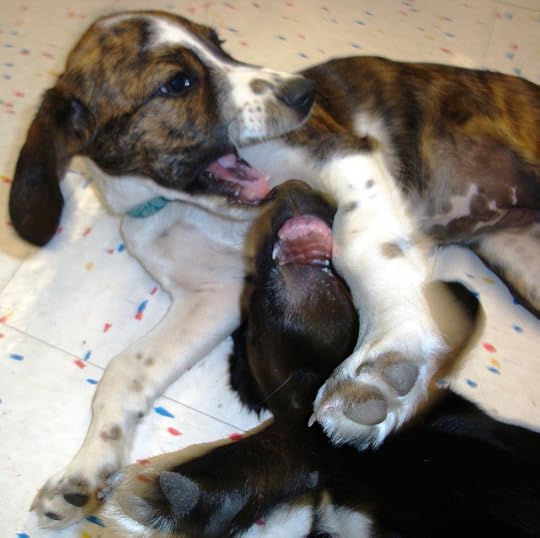Dog Aggression & What to Do

Play fighting can look and sound like the real thing.
Last month I attended the Western Veterinary Conference in Las Vegas. Yes, I know, it’s a tough job but someone has to do it. *s* During the week-long event, back to back seminars by veterinary experts offered the latest information on everything from chicken antibiotics and ferret care, to large animal info and—of course—cat and dog treatments.
Some of y’all know that I also write puppy-licious information at puppies.about.com and I’d just posted a series of articles on kinds of aggression. Guess what? The labels for one of the most common kinds has changed! So yet again, I’ve updated those articles as well as the ComPETability: Dog book (stay tuned shortly for the audio and print versions!), and wanted to share the information here.
It’s now called conflict aggression, but it used to be termed dominance aggression. The new descriptor makes lots more sense, though, because dogs that display this type of aggression act anything but “dominant” and instead do appear to be conflicted about how to act and what to do.
9 KINDS OF AGGRESSION & WHAT TO DO
Status Related Aggression can develop as the young dog matures and tries to find his or her place in the canine family group.
Sibling Rivalry has to do with interdog aggression and can be especially problematic when the younger pooch decides to challenge the older dog.
Fear Aggression is one of the most common types. Fear components can be part of nearly all the other kinds of aggression!
Conflict Aggression (used to be termed dominance) includes resource guarding (his bowl, toys, your bed!) and is directed at people.
Leash Aggression happens toward other pets or people when the dog is confined on a leash.
Territorial Aggression has to do with defending turf. We want dogs to protect us and our property–but it can go too far.
Predatory & Play Aggression can be normal for playful dogs–but can turn predatory toward smaller pets or infants.
Excitement Aggression often happens in doorways and hallways when the pooch gets too wound up.
Alliance Aggression appears to be uncommon but happens when one dog guards the owner from the other pets in the home–when you aren’t there the dogs get along.
Of course, aggression in and of itself isn’t necessarily evil and within the right context can be perfectly normal. Aggression always happens for a reason. Dogs and pups can be provoked into aggression by all kinds of clueless human behavior–it makes sense to the dog, of course! So to prevent dangerous aggression that can get you bit and lose your dog his home or even his life, it’s vital to learn how to understand doggy language.
Does this help with understanding canine aggression? What have been your experiences with your pets? How have you managed or prevented/avoided the problem?
Your email:
I love hearing from you, so please share comments and questions. Do you have an ASK AMY question you’d like answered? Do you have a new kitten and need answers? Stay up to date on all the latest just subscribe the blog, “like” me on Facebook, listen to the weekly radio show, check out weekly FREE PUPPY CARE newsletter, and sign up for Pet Peeves newsletter. Stay up to date with the latest book give aways and appearances related to my THRILLERS WITH BITE!



